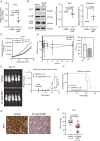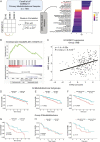EYA2 tyrosine phosphatase inhibition reduces MYC and prevents medulloblastoma progression
- PMID: 37486991
- PMCID: PMC10708924
- DOI: 10.1093/neuonc/noad128
EYA2 tyrosine phosphatase inhibition reduces MYC and prevents medulloblastoma progression
Abstract
Background: Medulloblastoma is the most common pediatric brain malignancy. Patients with the Group 3 subtype of medulloblastoma (MB) often exhibit MYC amplification and/or overexpression and have the poorest prognosis. While Group 3 MB is known to be highly dependent on MYC, direct targeting of MYC remains elusive.
Methods: Patient gene expression data were used to identify highly expressed EYA2 in Group 3 MB samples, assess the correlation between EYA2 and MYC, and examine patient survival. Genetic and pharmacological studies were performed on EYA2 in Group 3 derived MB cell models to assess MYC regulation and viability in vitro and in vivo.
Results: EYA2 is more highly expressed in Group 3 MB than other MB subgroups and is essential for Group 3 MB growth in vitro and in vivo. EYA2 regulates MYC expression and protein stability in Group 3 MB, resulting in global alterations of MYC transcription. Inhibition of EYA2 tyrosine phosphatase activity, using a novel small molecule inhibitor (NCGC00249987, or 9987), significantly decreases Group 3 MB MYC expression in both flank and intracranial growth in vivo. Human MB RNA-seq data show that EYA2 and MYC are significantly positively correlated, high EYA2 expression is significantly associated with a MYC transcriptional signature, and patients with high EYA2 and MYC expression have worse prognoses than those that do not express both genes at high levels.
Conclusions: Our data demonstrate that EYA2 is a critical regulator of MYC in Group 3 MB and suggest a novel therapeutic avenue to target this highly lethal disease.
Keywords: EYA2; Group 3 medulloblastoma; MYC.
© The Author(s) 2023. Published by Oxford University Press on behalf of the Society for Neuro-Oncology. All rights reserved. For permissions, please e-mail: journals.permissions@oup.com.
Conflict of interest statement
JME has provided consulting services to Eli Lilly and Co. and Gilead Sciences Inc. and serves on the advisory board of Perha Pharmaceuticals. All other authors declare no conflicts of interest.
Figures






References
Publication types
MeSH terms
Substances
Grants and funding
LinkOut - more resources
Full Text Sources
Molecular Biology Databases
Miscellaneous

